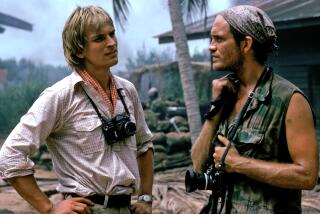TV SERIES INTRODUCES THE ‘UNKNOWN CHAPLIN’
- Share via
The mystery of how any artist creates is usually less mysterious than it is wearying: by trying and rejecting, again and again and again.
Usually that process is private and unrecorded. But tonight, genius is revealed in some of the most illuminating and remarkable moments on film. “Unknown Chaplin,” a prize-winning series made in 1982 by Kevin Brownlow and David Gill for Britain’s Thames Television, airs on PBS.
A three-part series on successive Mondays, it begins tonight at 8 on Channel 50; 9 on Channels 28 and 15, and 10 on Channel 24.
Charlie Chaplin’s secret turns out to be a process of trying and rejecting, again and again, but watching this process is mesmerizing stuff. Chaplin created on film, printing every take. No story boards. No scripts. No continuity girl. Only an idea in his head, using the raw material of actors--props and sets. And all of it under constant, unending pressure. As his consummate biographer, David Robinson commented, “Film was cheap, gags were hard.”
Just how hard, we see in detail. This footage is the cache that film collectors had fantasized about for years: outtakes, rushes, the nuts and bolts behind the effortless gesture. Presumably, all of it had been destroyed, on Chaplin’s own strict orders. But the man responsible for burning the masses of footage when Chaplin closed his studio in 1952 didn’t do his work very efficiently; several hundred reels survived, providing the material for this inestimable record.
Tonight’s program is the period Chaplin called “My Happiest Years,” the time he spent making a dozen two-reel comedies for the Mutual Film Co. (Part of the happiness may have come from the fact that his pact with Mutual made him, at the age of 27, 1916’s highest paid performer, $670,000 annually plus a bonus.)
The films are crammed with inventiveness and with a sense of Chaplin’s full rein as director-star. Props are created, dismissed with the wave of a hand, summoned up again. Enchanted by the comic ideas lurking in an escalator, Chaplin has one built for “The Floorwalker”; we watch him and the hulking Scotsman Eric Campbell thunder up, down and around it. Each gag is a numbered film slate; they begin to accumulate by the hundreds.
In “The Cure,” at a health spa, Champlin repeats a scene 12 times without being able to improve it. A wheelchair is a prop, then two. Suddenly there is plethora of them, with Charlie directing traffic.
In outtakes from “Behind the Scenes,” a parody of life backstage at the Mack Sennett studios, Edna Purviance (who had caught his eye off-screen as well) and Chaplin break each other up. She’s not as inventive an actress as the hardy vaudevillians in his cast, but Purviance’s humor is on the same wavelength as Chaplin’s. And it shows. For this short, Chaplin created the dance of the cleaning ladies, as well as the harrowing gag with the executioner’s ax, which again and again narrowly misses those famous feet. (Then Brownlow and Gill reveal just how narrowly.)
You can come to “The Unknown Chaplin” a reluctant fan--one of that band that prefers Buster Keaton’s stoic tragic mien--and be swept away in admiration for the delicacy of Chaplin’s movement, the exquisiteness of his timing. And when it is laid out this way, in a fountain of inventiveness that rises, falls and rises again, Chaplin’s magic becomes clear and irresistible.
Next week, “The Great Director”: the anguish behind his “simplest” feature, “City Lights,” Chaplin’s own favorite. With interviews with Virginia Cherrill, Robert Parrish, Lita Grey Chaplin, Georgia Hale, Jackie Coogan.
More to Read
The complete guide to home viewing
Get Screen Gab for everything about the TV shows and streaming movies everyone’s talking about.
You may occasionally receive promotional content from the Los Angeles Times.






